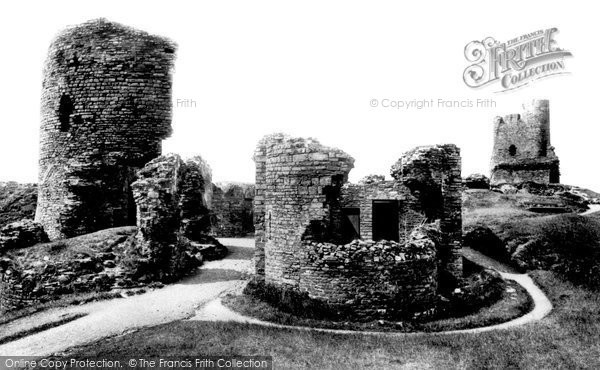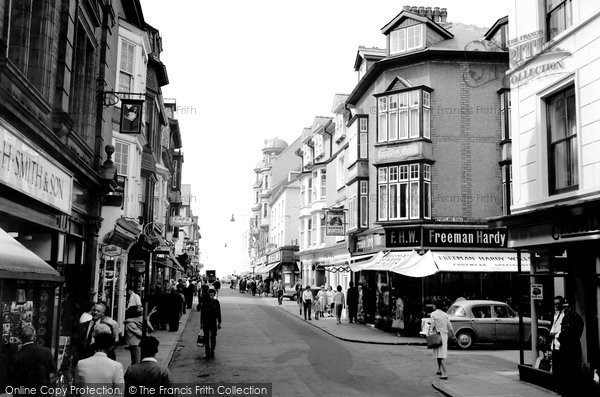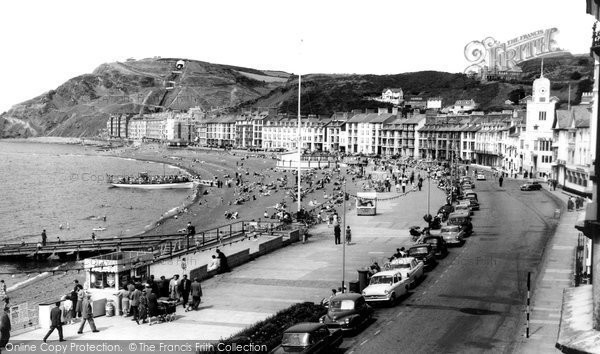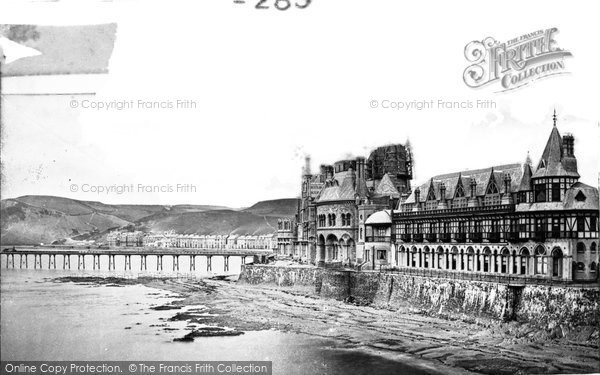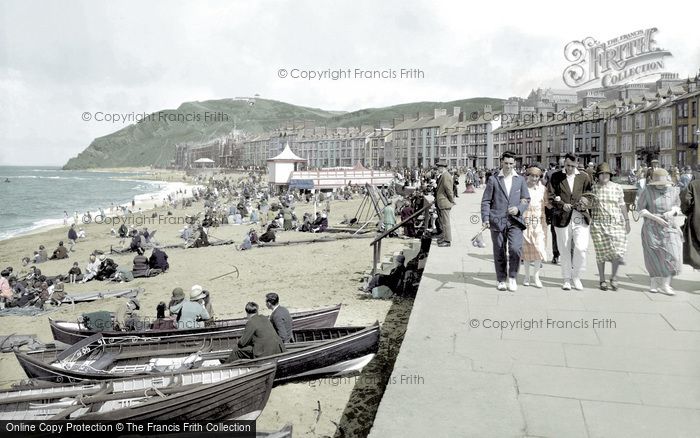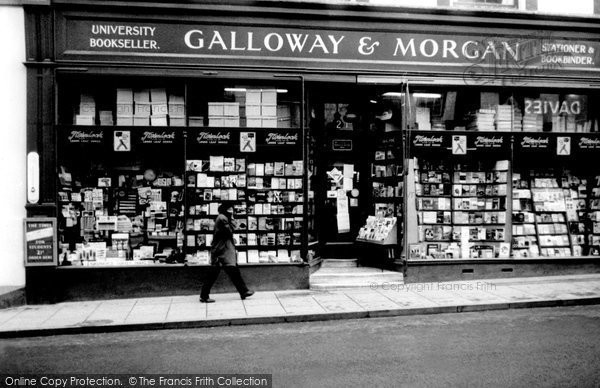Aberystwyth History
The history of Aberystwyth and specially selected photographs
Aberystwyth is an unusual town in many ways. It was created as a garrison town by an English king to control the native population but was little more than a small market and fishing village until English visitors began to come at the end of the 18th century. Following rapid growth, mostly during the Victorian period, it developed to become what many describe as the cultural capital of Wales.
The earliest evidence of settlers in the town has been found around the harbour. This consists of flint tools that date to the Mesolithic period, perhaps 7000 – 5000 BC when the coast was several miles further out. The remains may represent little more than a season’s settlement around a small lake or river by people who hunted small woodland animals such as boar and deer and caught fish. Remains of submerged forests of this date are found on the coast at Ynyslas, Borth and Llanrhystud. The tools from this site may have been made from flint that was dredged up from the Irish Sea and dumped on the coast.
By 5500 BC the sea had reached its present level and much of Britain was covered by forest.
During the succeeding Neolithic period (4000 – 2000 BC), stone axes were used to make clearings in the forest by those who had learnt to grow crops. One such axe was found on Pen Dinas. If the harvests were successful the Neolithic people had time to devote to activities other than gathering and hunting food. One of these activities was the building of stone chambers for the burial of their dead. A large stone in the middle of Llanbadarn Fawr village was thought by some to be the remains of one of these chambers, and a drawing of it on a late 18th century map certainly makes it look like one, but the surviving slab is quite unlike any other burial chamber slab in Wales. An axe of the Bronze Age (2000-750 BC) was found on Pen Dinas, and there are several burial mounds in the area as well as remains of a settlement in Llanilar of the period. The defensive ditches around Pen Dinas are clearly visible from much of the town: excavations during the 1930s indicate that it was occupied during the late Iron Age, perhaps during the 3rd-1st century BC. The evidence shows that the southern part of the hill was occupied first, then the northern, higher hill, and finally the two were joined by ditches across the neck of land between them. Very little evidence of settlement on the site was discovered and it is difficult to believe that people would have chosen to live on such an exposed site except during times of celebration or attack.
The Romans built a road through the county from north to south along which they established forts. The nearest of these is at Capel Bangor, six miles away. They abandoned the forts in about AD120, but hoards of later Roman coins have been found in the area. Graves discovered at Gogerddan have been dated to the 4th century, that is, of late Roman date but their orientation and lack of grave goods suggest that they are the graves of early Christians. However, the earliest known Christians in the area are associated with St Padarn, said to be a contemporary and friend of St David (who died in 588). Padarn is said to have established the church and monastery at Llanbadarn Fawr, one mile to the east of Aberystwyth. No archaeological remains of the church or monastery have been discovered, but two 10th and 11th century crosses survive on the site. We do know that the site was attacked by the Vikings in 988 and by Welsh princes at other times during the 11th century, and that it became a very important place of learning by the 11th century under abbot Sulian and his sons.
We have more references to the history of the area for the period between about 1100 and 1350 than for the next three centuries. This is partly because the main source of information – the ‘Brut y Tywysogyon’ (‘The Chronicle of the Princes’) was almost certainly at St Padarn’s in Llanbadarn Fawr between about 1050 and 1175 and the works of Edward I and his successors who retained direct control of the county after 1277 are well documented in the national archives.
The Normans ‘ravaged’ Ceredigion in 1073 and 1074 but didn’t build castles in south-west Wales until 1093 of which all but two were soon destroyed by the Welsh. In 1110 an earth and timber castle was built at Tan-y-Castell on the Ystwyth to the south of Pen Dinas: this was the first settlement to be called Aberystwyth. Having taken control of the area, the Normans gave the church of St Padarn to the monastery of St Peter’s in Gloucester. In 1116 the Welsh attacked a number of castles in the area, including the one at Tan-y-castell. This attack was the subject of a very detailed account in the ‘Brut y Tywysogyon’, presumably written by the monks at St Padarn’s from whom the Welsh warriors stole their supper the night before. It describes how the Normans tricked the Welsh into exposing themselves to a counter-attack and ends by stating that the ‘whole land was left to waste’.
It appears that the Normans continued to occupy the castle for another 20 years but in 1136 a number of castles in Ceredigion, including Aberystwyth, were destroyed by the Welsh from Gwynedd. It appears that one of these, Cadwaladwr, rebuilt it for himself. We know that his nephew, Hywel ab Owain destroyed it in 1143 during a family feud. In 1158 the Normans returned in force and ‘provisioned’ a number of castles near Aberystwyth, but Aberystwyth itself is not mentioned. All these newly defended castles were destroyed the following year by Lord Rhys, one of the most powerful men in Wales, but it appears that some were soon rebuilt by the Normans. One may have built in Aberystwyth on a different site to the original, since we know that a castle referred to as Aber-rheidol was destroyed in 1164 by Lord Rhys. We don’t know where this castle was, but it is possible that it was built on the outcrop of rock in the Rheidol valley where Plas Crug school now stands. An alternative site for this castle is under the present stone castle, or possibly on the Buarth.
There was peace under Lord Rhys until just before his death in 1197. In 1188 Archbishop Baldwin travelled around Wales to gather volunteers for the third crusade. The Archbishop was accompanied by Gerald of Wales, who kept an account of the journey, but although he criticised the behaviour of the wicked officials at St Padarn’s he tells us nothing of the church or monastery. It is assumed that it was a timber building. The church was built in stone in about 1200 (the only other stone buildings in the county were Cardigan Castle and Strata Florida, both built by Lord Rhys). Gerald tells us in his ‘Description of Wales’ that the Ystwyth flowed into the sea ‘below Aberystwyth Castle’ suggesting that one was still occupied on the original site after Rhys destroyed Aber-Rheidol.
The last few years of Rhys’s lordship were clouded by fighting amongst his sons. In the year that he died, (1197) one of his sons, Maelgwyn, took the castle and, according to one of the versions of the ‘Brut y Tywysogyon’, the town of Aberystwyth from his brother Gruffudd. In 1208 Maelgwyn destroyed the castle to stop Llywelyn Fawr of Gwynedd from taking it, but Llywelyn took the cantref (hundred) of Penweddig within which Aberystwyth stood and rebuilt the castle. In 1211 the Normans built or strengthened a castle at Aberystwyth, but it was destroyed almost immediately by Maelgwyn. It appears that Maelgwyn’s nephew Rhys ap Gruffydd built a llys, or court, in Aberystwyth since we know that Llywelyn Fawr took it in 1221. The location of this llys is uncertain, but it may also have been at Plas Crug.
There are no more references to castles in Aberystwyth until Edmund, brother of Edward I, arrived on 25 July 1277 to supervise the laying-out of the new castle and town.
The site chosen for the castle was on the coast so it could be supplied by sea, both for building materials (although it seems that some was shipped from Bristol to Carmarthen and thence by land) and during times of attack. It was on the boundary of the northern kingdom of Gwynedd and the Anglicised south, and it was a suitable site for a harbour. Aberystwyth was one of four castles that were started in 1277 - the others were Builth, Flint and Rhuddlan.
The castle took 12 years to complete, during which time it was attacked twice. The first time, in 1282, followers of Llywelyn the Last and others invited the constable of the castle to have a meal with them. They seized him, burnt the town and castle, destroyed the town walls and killed the inhabitants but spared the garrison. After this, it appears that there was a change of plan under a new architect. The new building was to be completely concentric and a barbican was built to strengthen the entrance. In 1287 the castle was attacked by Rhys ap Maredudd but only part of the town wall was destroyed. The carpenters Robert and Nicholas were paid to ‘put the castle on a war footing’. After the attack the Normans gathered a large army to fight Rhys. On 13 August 1287 6,600 ranks and 47 officers left Aberystwyth to join others in Cardigan. It is possible that this was the largest number of people who gathered in Aberystwyth at one time until the coming of the railways.
The town and castle were attacked for a third time in 1284, when they were besieged by the Welsh for about six months, but the occupants were relieved by supplies brought by sea. This rebellion was instigated by insensitive English administration and taxation and began with the murder of Geoffrey Clement at Cardigan. He was custodian of Aberystwyth Castle and during the siege of the castle his widow, Margery, took refuge in Aberystwyth. She appears on the list of burgesses in the town in 1307.
The Cost of Building the Castle: The expenditure of almost every half penny spent on the castle was recorded and the original accounts survive, showing that it cost at least £4,300. We know that William the plumber’s assistant was paid 2d (just under 1p) per day and the master mason was paid 12d (5p) per day. Building work was not carried out during winter months so it is possible that hundreds of people were employed during part of the year, either at the castle or elsewhere, gathering, preparing and transporting materials etc.
The castle was built to the same concentric plan as most of the other castle built in Wales at the time – a castle within a castle with a massive gateway but unlike the others it was thoroughly demolished on the orders of Cromwell in 1649. In 1739 the corporation announced that it would fine anyone caught removing stone from the castle. Towards the end of the century the owner laid out gravel paths around it and built a summer-house on Castle Point for visitors.
Why is the Town Called Aberystwyth? The town of Aberystwyth is on the Rheidol, not the Ystwyth, and should be called Aber-rheidol. The original earth and timber castle was built in 1110 on a hill overlooking the Ystwyth and was named Aber-ystwyth (the mouth of the Ystwyth). There is a reference to a castle called Aber-rheidol in 1164, which was presumably near the present town but its location is unknown. The original charter of 1277 refers to the town as Llanbadr (derived from the parish name Llanbadarn) and later documents refer to it as Llanbadarn Gaerog (fortified Llanbadarn). In 1402 and 1404 during the occupation of the town by Owain Glyndwr, the castle and town were referred to as Aberystwyth. Later documents refer to it as Llanbadarn until the reign of Queen Elizabeth I, after which it is always referred to as Aberystwyth. The original spelling of the name of the town was Aberystwyth, but during the 18th or 19th century, it was frequently spelt Aberystwith, probably as a result of English influence. In December 1890, the town council decided to make Aberystwyth the official spelling.
Further Reading
To discover the histories of other local UK places, visit our Frith History homepage.
Aberystwyth History in Photos
More Aberystwyth PhotosMore Aberystwyth history
What you are reading here about Aberystwyth are excerpts from our book Aberystwyth - A History and Celebration by Michael Freeman, just one of our A History & Celebration books.


